Don’t you hate reading those signs on the side of the road that say, “If you lived here you’d be home by now”. I guarantee you won’t see them on the approach to Croajingolong National Park in East Gippsland. Proximity to the major population centres is something Croajingolong definitely can’t claim. Then again, I reckon that could be its best feature.
Croajingolong is a perfect holiday destination for an angler because there are an amazing number of quality fishing options and locations. There’s also plenty of walking and coastal scenery to explore, so if, like me, your camping companions have a short angling concentration span – no problem! When my partner Deb suggested we spend a long weekend away camping at Thurra River, who was I to say no?
Thurra River is in the Croajingolong National Park about 450km east of Melbourne. Croajingolong extends along the coast from Sydenham Inlet all the way to the NSW border. It covers an area of 87, 500 hectares, offering a multitude of wilderness fishing opportunities.
Getting to Thurra River from Melbourne is straightforward. Follow the Princess Highway east from Melbourne to Cann River, and then turn right and follow the signs to Point Hicks. No GPS necessary! It will take you about 6 hours in total from Melbourne.
Although most of the distance is under your belt when you arrive at Cann River, you should allow a further hour from here to arrive at the campground at Thurra River. It’s only about 40km, but the road is mostly unsealed (although suitable for 2WD). The Point Hicks Road also gets you to Tamboon Inlet, the beach at Clinton Rocks and the Mueller River – all great fishing locations.
There are two basic options if staying overnight in this part of the world (and because of its isolation you will almost certainly need to stay at least one night). You can camp at Tamboon Inlet, Thurra River or Mueller River campgrounds, or, alternatively, there is the option of booking accommodation at the Point Hicks Lighthouse. Whichever you choose, you can contact the Lighthouse to make arrangements. If choosing to camp, you only need to prebook during the holiday periods. The rest of the year, a friendly bloke from the Lighthouse will do the rounds of the campsite each evening to collect fees.
Thurra River is the largest campground in the Croajingolong National Park, with 46 campsites. Just down the road is the Mueller River campground, with 8 sites. You will see the turn off to Mueller River on your left, about 6km prior to the Thurra River campsite on Point Hicks Road. There are also 12 sites at the campsite at Peachtree Creek, Tamboon Inlet.
There is usually only a limited amount of freshwater available at the Thurra and Mueller sites, so it’s better to be safe and bring your own. They also each have good pit toilets, complete with their own healthy population of mosquitoes…you have been warned! It’s probably wise to bring your own toilet paper. There’s usually some supplied, but do you want to take the chance of finding out the hard way?
There are several fishing options in the area, which can basically be divided into estuary and surf fishing. Although Tamboon inlet is not far up the road, it’s not the focus of this article, but the same techniques and species are on offer.
The river fishing options include the Thurra and Mueller rivers, If you’re a serious fishing nut and really want to devote your trip to river fishing, then it’s probably best to camp at the Mueller River, which is about 6km down the road. You will pass the turn-off on your way into Thurra River.
There is also easy access at both campsites to the surf beach. If you’re heading further down the road to Point Hicks Lighthouse, you should be aware that the Point Hicks Marine Park starts just east of the Lighthouse, which precludes fishing in this area. There are signs on the road to indicate where the Marine Park starts. All other locations east of this point are OK to fish, including the immediate vicinities around the Thurra and Mueller river mouths.
The list of target species includes the usual fare of Australian salmon, tailor and gummy sharks from the surf, as well as flathead, bream, estuary perch, salmon, tailor, mulloway and mullet in the estuary. For the more intrepid fishos adventuring further up the rivers, Australian bass are also on offer.
Although I porefer to fish with lures or flies, traditional bait fishing techniques are, of course, also effective in these parts.
From the surf on those days where the water is clean and the gutters not too far from the shore, I like to walk along the beach tossing a metal lure for salmon and tailor. When we were there, this technique worked a treat, and I managed to snag several good fish. What often surprises me when fishing this way is the number of relatively small fish that are willing to take a 25g slice. Great sport on light gear!
Bait fishing with a paternoster rig on a 10-12ft surf rod would also do the trick, but this method limits the amount of water that you can cover. The few people that were bait fishing didn’t seem to be catching as many fish as I was spinning up. This is most likely because I was covering more water while spinning. And when you do find that purple patch…hang on!
In contrast to the pounding surf, the river fishing is more sedate…or at least it would have been if on the first day of our trip if there had been more water in Thurra River.
The fishing guidebooks say that the lower section of the Thurra is shallow, and that this is followed by an area known as the Thurra swamps, prior to opening up into a much deeper river upstream.
We set about paddling our sea kayaks upstream in search of Nirvana, the elusive deep water, and, of course, the those massive fish that had never seen humans that must surely be there.
After several hours literally dragging our kayaks up a very shallow river and eventually coming to an impassable logjam, we climbed a large, steep sand dune to see in the far distance the deep and almost unreachable part of the river that looked very, very fishy from afar…maybe next trip.
Apparently this part of the river can normally be more easily accessed, but the combination of the Gippsland floods and shifting sand dunes have created a large blockage of trees that made it virtually impossible to drag our kayaks through. Needless to say, the next day we headed straight for the Mueller River.
In contrast to the Thurra, the Mueller is a large estuary system that looks very fishy in all directions. True to form, within 10 minutes of entering the river, and on about the fifth cast, Deb hooked into a solid estuary perch of well over 1kg on a Squidgy flickbait.
We were off to a good start. My only problem was that Deb had caught the first fish, and a solid one at that. It was now my turn to catch up.
Unfortunately I couldn’t match her estuary perch for the trip, but I did manage to hook into some smaller salmon and a very nice tailor. The tailor was caught trolling a soft plastic lure from the kayak, and it put up a great fight on light gear.
We fished for several kilometres upstream and although the water looked good, the fishing was hard going. We decided to return downstream and fish the bank near the mouth using soft plastics. This proved to be very productive as we hooked into several salmon, which were all caught and released.
A kayak is ideal for fishing the Mueller River. A small tinny would also be good. Although there is no formal boat ramp, there is a parking area where you can manhandle craft into the water.
I spent our last evening spin fishing along the surf between the Thurra and Mueller rivers, and had the best session of fishing for the trip. I was consistently hooking into salmon of over 1kg, and tailor of over 2kg. They all put up a great tussle on the relatively light gear that I was using.
As I was standing there on the beach with the sun setting, I thought about the enormous wilderness of the Croajingolong National Park. I wondered when next I’d be back, and whether I would have enough spare time in my life to fish and explore it all? Sadly, I think the answer is no…but I wouldn’t mind trying!
Facts
1
GEARING UP
Fishing in the Thurra or Mueller rivers requires little more than a light bream rod or flick stick. I was using 6lb Fireline, with 6lb fluorocarbon leader on both 1500 and 2500 Sahara Shimano reels. I also took along an 8 weight flyrod, although a 6 weight would have been ideal for the river.
For the surf, I was using a 3500 Sienna Shimano reel spooled with 15lb monofilament. The heavier mono restricted casting distance, so next trip I would probably replace this line with the equivalent strength braid. A short three-piece graphite travel rod was matched to this reel.
POINT HICKS LIGHTHOUSE
The Point Hicks lighthouse was built in 1887-88, and was first lit in May 1890. The kerosene lamp and clock mechanism were upgraded to electric operation with the connection of mains power in 1965. The light has more recently been converted to solar power.
Original access to Point Hicks was by sea and the remains of the old jetty can be seen a short distance from the lighthouse.
The lighthouse had a name change from Point Hicks to Cape Everard from 1843 until 1970, when it was changed back to Point Hicks. It seems there was some doubt about whether this was Captain Cook’s first landfall in Australia, in 1770, because Cook had not taken account of crossing the International Date Line when recording his log.
Nowadays the lighthouse is easily accessed by land. Visitors are welcome to stay at the lighthouse and can do so by calling the lighthouse keeper on 03 5158 4268.
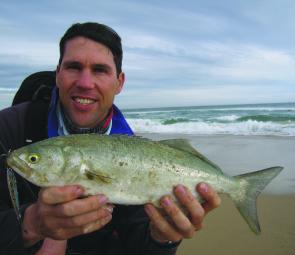
Casting metal lures into the surf from the beach between Thurra and Mueller rivers was a productive way to catch both salmon and tailor.
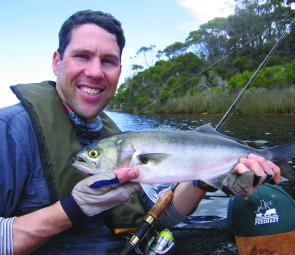
This tailor was caught trolling a soft plastic behind a kayak in the Mueller River. Kayaks and small boats are ideal for this waterway.
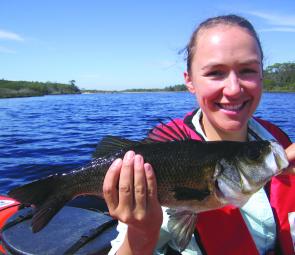
Estuary perch abound in both the Mueller and Thurra rivers. Deb Courtney caught this one from her kayak, using a Squidgy flickbait.
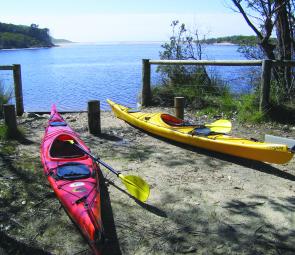
Although there is no formal boat ramp, there is a parking area next to the Mueller River where you can manhandle small craft into the water. Kayaks are ideal.
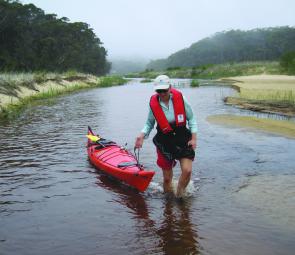
The lower reaches of the Thurra River are shallow and kayaks need to be dragged upstream.

Deb stands on a sand dune, from which the deeper water in the upper reaches of the Thurra River can be seen. They looked very fishy from afar…if only we could reach them!
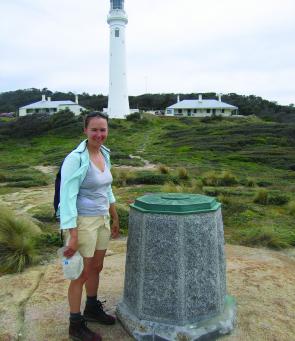
The historic Point Hicks Lighthouse represents the upper end of the accommodation options at Thurra River. You’ll need to book ahead, especially during school holidays.




